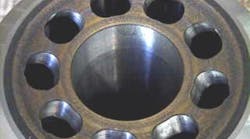I was asked recently to do a failure analysis on a hydraulic motor that was the subject of a warranty claim. The motor had failed after only 500 hours in service, some 7,000 hours short of its expected service life. Inspection revealed that the motor's bearings had failed through inadequate lubrication, as a result of the hydraulic motor being started with insufficient oil in its case (housing).
A common misconception among maintenance personnel with limited training in hydraulics, is that because oil circulates through hydraulic components in operation, no special attention is required during installation, beyond installing the component and connecting its hoses. Nothing could be further from the truth.
After this hydraulic motor was installed, its case should have been filled with clean hydraulic oil, prior to connection of its case drain line. Starting a piston-type motor or pump without doing so, is similar to starting an internal combustion engine with no oil in the sump - premature failure is pretty much guaranteed.
Now, some of you may be thinking that the case of this motor should have filled itself with hydraulic oil through internal leakage. In most instances it will, but not before the motor or pump has been damaged! And this damage may not show itself until the component fails prematurely, hundreds or even thousands of service hours after the event.
In this particular example the warranty claim was rejected on the basis of improper commissioning. And as a result, the customer was lumbered with an expensive repair bill. So as you can see, failing to follow proper commissioning procedures when installing hydraulic components can be a costly mistake. And to discover six other costly mistakes you want to be sure to avoid with your hydraulic equipment, get "Six Costly Mistakes Most Hydraulics Users Make... And How You Can Avoid Them!" available for FREE download here.

Continue Reading
Continue Reading
BOOK 2, CHAPTER 12: Fluid Motor Circuits
March 18, 2009
Motor leakage variations
Oct. 18, 2006
Sponsored Recommendations
Sponsored Recommendations
How Variable Volume Pumps Work
Feb. 6, 2024
What is a Check Valve and How Does it Work?
Feb. 6, 2024
